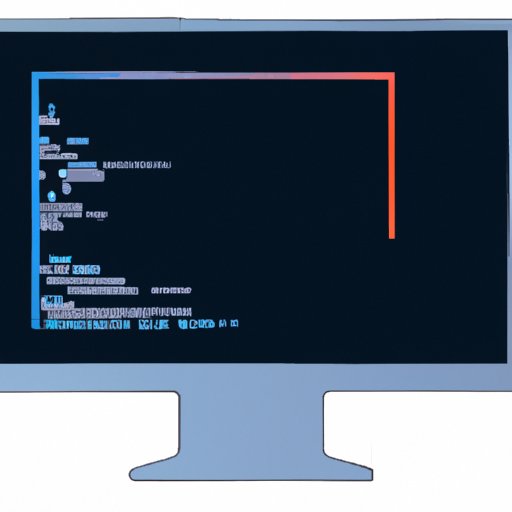Introduction
Have you ever found yourself in a situation where you needed to capture an important moment on your computer screen? Maybe you needed to save an image, take a snapshot of a message, or preserve some vital information. Screenshots are a useful and convenient tool that can help you capture moments on your device that you may not be able to access again. This article will provide a step-by-step guide on how to take a screenshot on a computer using different methods.
Step-by-Step Guide
There are three major types of screenshots: full screen, window, and specific area. Below is a detailed guide on how to take each type of screenshot:
- Full Screen Screenshot
- On Windows: Press the “PrtSc” (Print Screen) button located on the top row of your keyboard
- On Mac: Press “Command+Shift+3” keys altogether.
- After taking the screenshot, it will be saved to your clipboard, and you can paste it into an image editor such as Paint, or paste it directly into an email or document and save it there.
- Window Screenshot
- On Windows: Select the window you want to capture, then press “Alt+PrtSc” (Alt and Print Screen) buttons at the same time.
- On Mac: Press “Command+Shift+4”, then click on the window you want to capture with a crosshair cursor.
- Specific Area Screenshot
- On Windows: Press “Windows+Shift+S” keys simultaneously, then highlight the area you want to capture.
- On Mac: Press “Command+Shift+4”, then drag the crosshair cursor to select the area you want to capture.
Keyboard Shortcuts
Keyboard shortcuts are an efficient way to take screenshots without needing to make more than one click. Here are commonly used keyboard shortcuts for different devices:
- Windows
- “PrtSc” button: Captures the full screen
- “Alt+PrtSc” (Alt and Print Screen) buttons: captures the active window
- “Windows+Shift+S” keys: captures a specific area
- Mac
- “Command+Shift+3”: captures the full screen
- “Command+Shift+4”: captures a specific area
- “Command+Shift+4”, then Space: captures the active window
Tips for use of Keyboard Shortcuts: Keyboard shortcuts are faster and easier to use, but remembering them may take a while. Nonetheless, with regular use, muscle memory will come into effect and one can easily and swiftly make use of the shortcuts.
Using the Snipping Tool
The Snipping Tool is a built-in utility on Windows that enables users to take screenshots of any part of the screen and save it as an image. Here is a guide on how to use the Snipping Tool:
- Open the Snipping Tool by typing “snipping tool” in the search menu on the bottom left corner of the computer or use start menu search.
- Click “New” to start a screenshot. The screen will fade out with a crosshair cursor. Click and move the cursor to select the area of the screen you want to capture.
- You can then edit the screenshot to trim it, highlight certain areas with a pen tool, or save it as a .JPEG, .PNG, or .GIF file.
Third-Party Applications
There are numerous third-party tools that can be utilized for capturing screenshots that include more advanced features than Windows’ inbuilt facilities. Here are a few popular third-party applications:
- Lightshot: lightweight, easy-to-use editing tools, and cloud hosting for quick sharing.
- Greenshot: hotkeys that are customizable, advanced editing tools, and OCR extension for text recognition.
- Snagit: Activated by user-defined hotkeys, built-in templates for creating and customizing screenshots, professional graphics editor, and gestures feature.
Users have the option of choosing the application that suits their requirements while considering parameters like features, functionality, or user interface.
Saving and Sharing the Screenshot
After capturing a screenshot, the following options become available:
- Save the screenshot by clicking the “Save” button while using the Snipping tool, or by pressing “Ctrl+S” keys while using the Windows Print screen feature to open the Save As dialogue box.
- Sharing options may depend on the user’s preferences, such as email, file sharing services like Google Drive or Dropbox, or messaging apps like Whatsapp or Slack.
- Organizing and managing screenshots goes a long way. As long as the user makes a diligent note of files/folders, it becomes easy to locate them.
Advanced Tips
Enhance user experiences by taking into account certain best practices:
- Editing and Annotation – Users can edit, annotate, and modify screenshots using any photo editing software, which should provide basic tools for adding elements like texts, arrows, shapes, and highlights.
- Purpose-specific Screenshots – Different use-cases may require specific considerations. For example, a business presentation may demand high visual appeal and high-quality outputs. In contrast, tutorials require thorough annotation and explanation.
- Common Troubleshooting – Troubleshooting tips may include disregarding the error ‘files not saved’ by checking the version of the software being used, ensuring that the target file directories exist, or uninstalling and reinstalling software drivers/extensions.
Conclusion
The importance of knowing how to screenshot on a computer cannot be overemphasized. It can make your day-to-day life much easier, especially if you work with digital media, or if you are documenting something important. By following this guide, you’ll be able to take screenshots efficiently using different methods such as default keyboard shortcuts, the Snipping Tool, third-party applications, and more. Capture your screen anytime, anywhere, and share your visual message with others easily.
